13 Types of Spatulas for a Better Cooking Experience
Author: Anne Cowart | Editor: Omar Alonso
Review & Research: Jen Worst & Chris Miller
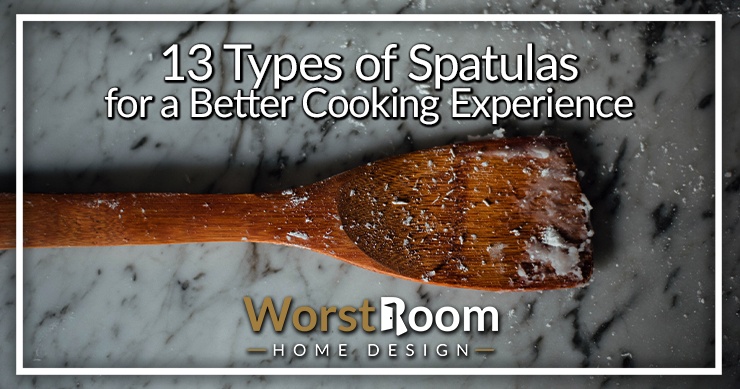
Let's take a moment and think — can you cook without even one of the different types of spatulas? You bet you can't. It's fascinating how this simple tool is a staple of every kitchen, yet we don't put much thought while purchasing a new one.
Even if you're a minimalist, you probably have three or more spatulas types in your kitchen. In its simplest form, a spatula has a strong handle and a narrow or wide blade that you use to mix, spread, and lift your food.
As they are used for various purposes, spatulas largely vary in their shapes, materials, and uses. A spatula specialized for baking might not be suitable for stirring or grilling.
To assist you in picking up the right spatula for the right occasion, here we will explore all the kinds of spatulas based on their design, material, and usage. So let's not waste much time and dive right in.
Types of Spatulas by Design
If you're visiting a store to buy a spatula, you'll come across many different shapes and sizes of this cooking tool. As we mentioned, all of them serve different purposes. Here are some of the most common spatulas that vary in their designs.
Fish Spatula
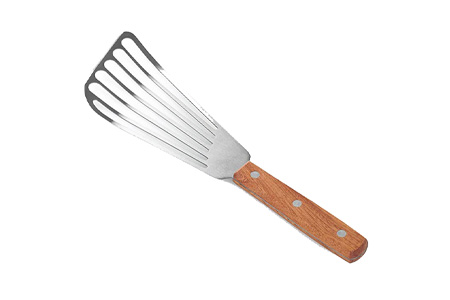
Being one of the most used cooking tools, fish spatulas are found in almost every kitchen. This spatula features an ergonomic handle and a flat, thin blade with sharp angles. It also has longitudinal slots along its surface, which help in draining the extra oil and fat chips from the food.
Usually, fish spatulas are used for frying and flipping protein items like fish and meat. As the fish fillets are delicate and break easily, this type of spatula helps you to flip the pieces without ruining their shapes. You can also use the spatula for cooking pancakes and poaching eggs.
For better performance, fish spatulas are mostly made of stainless steel or some other metal. This makes the tool rigid and flexible. However, you can also buy plastic or silicone-made fish spatulas if you prefer.
Offset Spatula
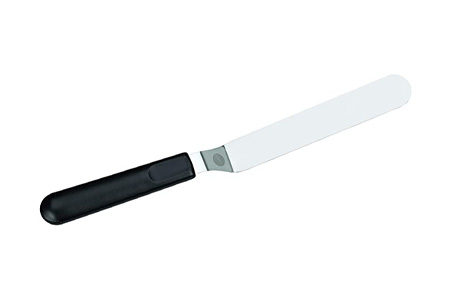
Also known as frosting or icing spatula, offset spatulas are essential for baking. We call this spatula 'offset' because the blade portion of this tool isn't in the same line as the handle.
The curve near the handle makes it easier to grip the handle without much pressure. It's particularly useful if you have arthritis or some other difficulties in your hands.
You can use the offset spatula for spreading frosting on every corner of the cake and for shaping the uneven edges. It is also useful for icing, making a sandwich, preparing cookies, and flipping pancakes.
Stainless steel and silicone are the most used material for making offset spatulas. Yet, some are also made of plastic.
To meet all your baking needs, these types of spatulas come in a dozen of sizes. Small ones are perfect if you're making a 6-inch cake. For larger and heavier ones, purchase the offset spatula with large handles and wide blades.
Perforated Spatula
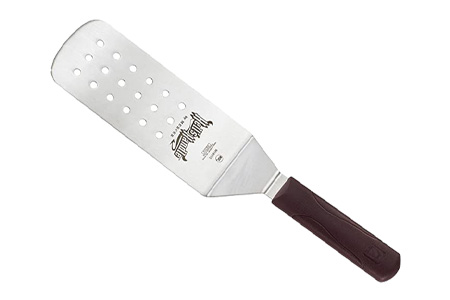
If you want spatula types for deep frying and grilling, you surely need a perforated spatula. Usually, this type of spatula has a long handle so that you can flip the food without going too close to the heated utensils.
As for the blade, it has a series of small holes along its surface, which easily drains the extra oil or sauce. Hence, it becomes super easy to collect the food from a hot skillet.
The blade of perforated spatulas is one of the widest among all the spatulas. It can be deep and round or flat and edged to suit different cooking styles.
Most perforated spatulas are made of stainless steel as the material is strong and withstands high temperatures. You can use this spatula for turning burger patties, making BBQ, cooking in different types of smokers, and frying meat.
You'll want to knock the extra crusty stuff out of the holes before running it through even the best types of dishwashers, still, as these kinds of spatulas will definitely harbor bacteria if you aren't thorough.
Flat Spatula
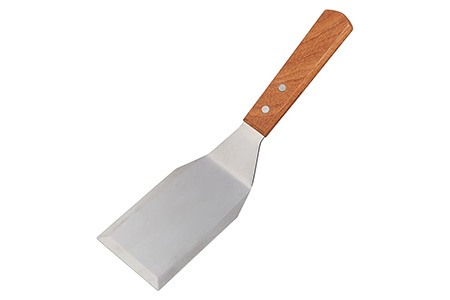
Being the most diverse spatula of this lineup, flat spatulas come in all kinds of materials, including wood, metal, and silicone. From small to large, they come in virtually all sizes.
Typically, the handle and the blade of this spatula are in the same line. Some might have a minor curve or dent near the handle.
You can use the flat spatulas for stirring your food, mixing dry ingredients, and removing food from a pan. You can scoop up scrambled, fried, or any other types of eggs easily with this much surface area. Also, the smaller ones are useful for scraping sticky liquid from measuring cups, stirring ingredients inside a grinder, and for spreading cream on a cake.
Giant Spatula
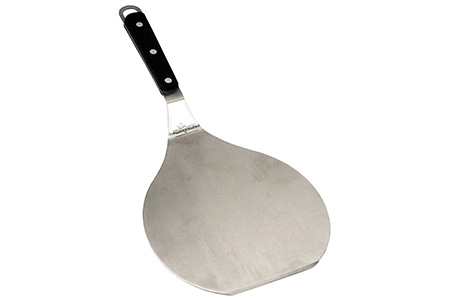
As the name suggests, this type of spatula is the largest and is used mostly by professional chefs. The spatula has a large handle that helps you bring out a dish from larger ovens and stoves.
As for the head of these types of spatulas, it can be rectangular and flat with sharp angles, or it can be completely circular. Both the handle and the blade are made thick to carry bigger pans and pots without touching.
Generally, giant spatulas are made from steel or other metal for strength, longevity, and better grip. You might spot these spatulas in bakeries and restaurants where they are used to transfer large pizzas and cakes.
Cake Spatula
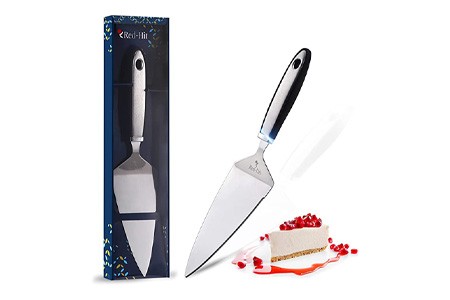
Another must-have spatula for professional bakers, the cake spatula has a very unique shape. These different kinds of spatulas have a plastic or wooden handle for better grip and a thin, tapering, and triangular blade.
Usually, the blade is made of metal or silicone, and there's a bend on the blade for better handling of food. The tapering tip of the cake spatula can reach tight spaces allowing you to spread the frosting evenly.
Similarly, it's a better choice for icing on cookies as it easily meets all the lines and edges of the dough. You can use the spatula to slice a cake and transfer small decorating objects like chocolate chips.
Half Spatula
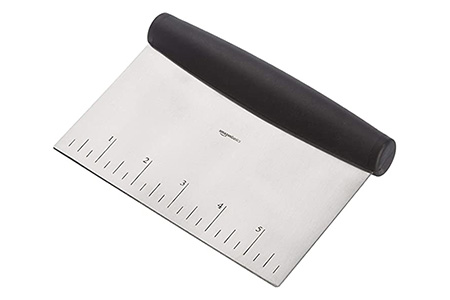
Commonly known as scrappers, half spatulas are used for scraping food residue from the bottom and sides of the utensils. They are also a good option to mix dry items in your cookie dough and for adding ingredients in whipped egg whites.
These spatula types have a rubber or plastic-made handle and a silicone head that looks like it has been chopped from one side. Due to the soft head, you can scrape the bottom of your non-stick cookware without peeling off the coating.
Grilling Spatula
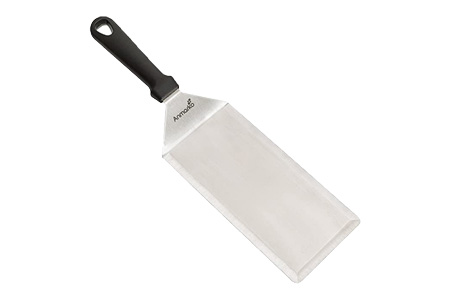
These are extremely sturdy spatulas made of solid metal with tapered edges. You won't want to use these on your teflon types of pans that could scratch easily, or any non-stick pan really.
These are made for BBQ grills or griddles, where they don't risk doing any damage and can be used to scrape up excess meat and help in cleaning the griddle or grill. They don't have any slots, slits, or holes, so they're easy to clean, too.
The best ones will have a bent handle that helps keep your hand a good two or three inches away from the heat source as well. This helps you use it as a smasher for burgers and other meat to help the heat make its way through.
Types of Spatulas by Material
Because of the health factors, very few materials are eligible for making spatulas. While choosing a material, you should consider the uses and advantages. Below are the most common spatula materials with their benefits and drawbacks.
Metal Spatula
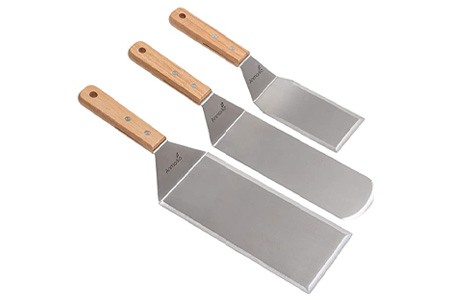
For handling heavy food items and rough jobs, metal spatulas are simply the finest. They can be made of stainless steel, aluminum, or iron and come in various shapes and sizes.
Among all the materials, it's the most strong and durable. It doesn't require any maintenance, and you can clean the spatula just by wiping it with a dry cloth.
Metal spatulas are also dishwasher safe. Most importantly, all the metal spatulas are non-toxic and completely safe for your health.
Although this type of spatula can withstand the highest heat on whatever types of stoves without melting, it retains heat very easily, causing accidental burns if not careful.
Moreover, metal spatulas are expensive compared to other materials. You need to be extra careful while using them with granite types of countertops or cast iron utensils.
Wooden Spatula
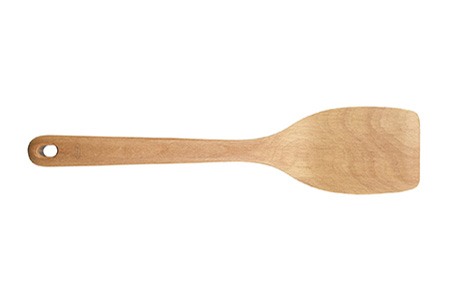
If you want a non-toxic and eco-friendly alternative, you can go for wooden spatulas with their many pros and few cons. This material is almost as durable as metal, and with proper maintenance, it can last for decades.
Moreover, wood isn't a good conductor of heat. And so, the handle won't get heated easily no matter how long you cook.
Another positive aspect of wood spatulas is that they look very pleasant from an aesthetic point. As the edges of a wooden spatula are blunt, they don't harm the coating of your skillets. A few drawbacks of the material include the need for high maintenance.
Besides, you need to clean and dry these types of spatulas thoroughly after every use. That's because wooden surfaces are porous and susceptible to bacteria and other microbes. Keep the wood spatulas away from raw meat to avoid such health hazards.
Silicone Spatula
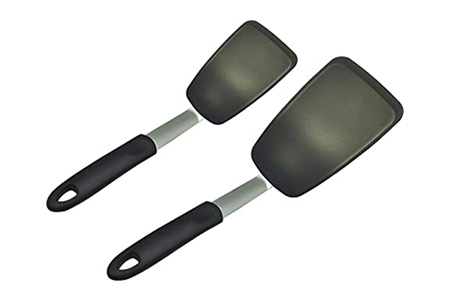
Silicone spatulas are trending on the marketplace for their low price and overall satisfactory performance. As the material is synthetic, it's pretty long-lasting even if you use it regularly. They come in various striking colors and textures so that you can choose according to your taste.
Even in high temperatures, the material doesn't lose its texture and remains perfectly cool. You don't need to concern yourself about cleaning or other fancy upkeep as the silicone surface is dishwasher safe and resists microorganisms well.
The best part is, they are available at very cheap prices, and you can buy them in various sizes and designs.
However, silicone types of spatulas can't hold oily food items properly. You need to be careful while using them with food items with a strong odor, as the spatula traps the smell easily and transfers it to other dishes.
Plastic Spatula
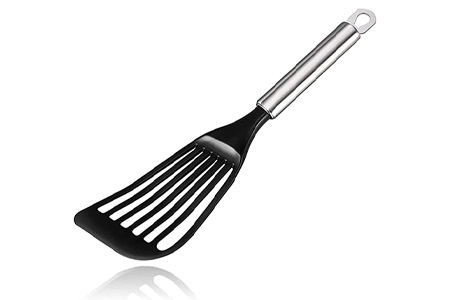
Among all the materials, plastic is the cheapest and most available one. This type of spatulas also come in various colors and sizes. You can easily clean them and use them with your non-stick pots and pans. It's a decent material for mixing, tossing, and stirring jobs.
Despite its merits, plastic isn't a widely used or recommended material for a bunch of reasons. Plastic spatula types can deform and emit toxic gases in high heat. If you pull food right out of whatever types of ovens you have, don't immediately reach for a plastic spatula, but a metal one.
Also, the material isn't as durable like the other ones of this lineup. These different kinds of spatulas work fine for quick use in frying pans like flipping eggs or steaks, but you don't want to let them linger in the heat for too long.
Rubber Spatula
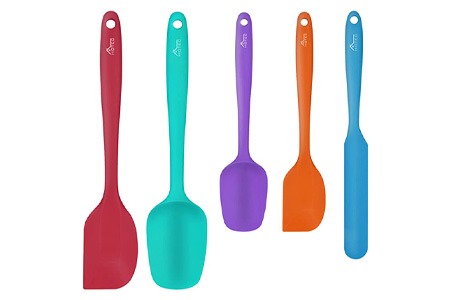
In my opinion, you should skip plastic and rubber and go straight to a silicon spatula, but if you want to save some money, definitely choose rubber over plastic. A rubber spatula comes with the pros of plastic without many of the cons.
For instance, rubber is softer and more pliable than plastic, which is good for wiping around bowls and not having waste. They can take heat just as well as plastic but won't bubble or have any undesirable off-gas.
The one negative of rubber is that it can stain fairly easily, so while you may use it for spreading types of frosting, you'll want to stay away from any types of pasta sauce or curry, as examples.
Types of Spatulas for Every Pan & Meal
Now you know all the different types of spatulas available in the marketplace. As you can see, every spatula is different and suitable for distinct uses. So choose the designs as per your needs. Make sure the material is non-toxic and easy to maintain. And that will be enough for convenient cooking and a healthy meal.




